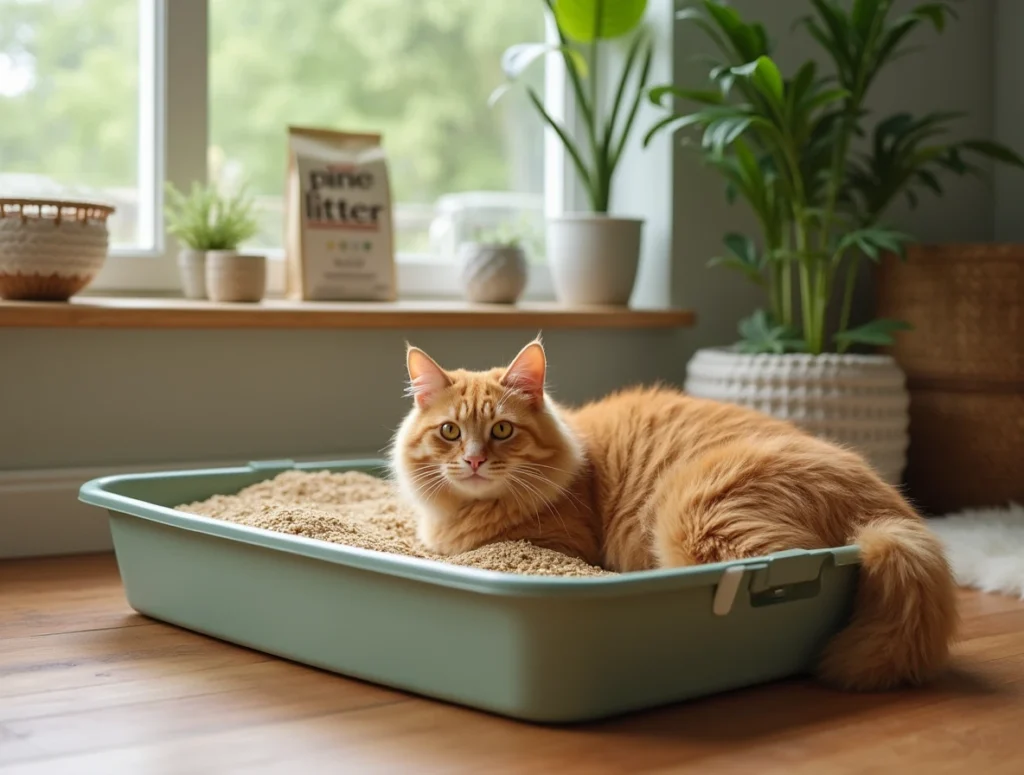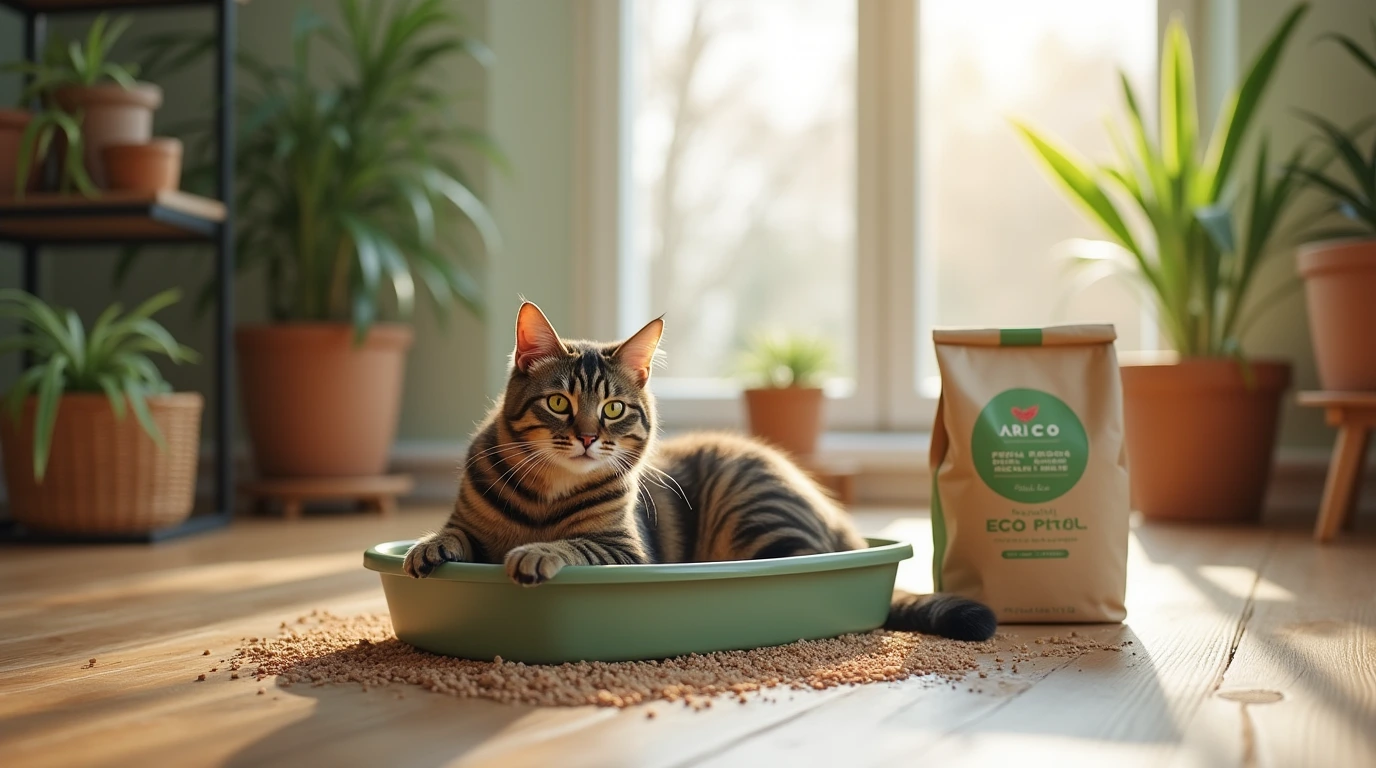Pine Litter: Everything You Need to Know for Your Feline Friend
Cats are more than just pets—they’re cherished members of your family. They bring joy, companionship, and comfort to your life, and in return, you want to provide the best possible care. Just like every other family member, your cat’s health and happiness are top priorities. While you may already focus on providing quality food, regular veterinary checkups, and cozy resting spots, one often overlooked but essential aspect of feline care is choosing the right litter.
The litter box is a significant part of your cat’s daily life, and the type of litter you select can directly impact their well-being. Enter pine litter, a natural, eco-friendly solution that’s gaining traction among cat owners. Made from reclaimed wood, it offers benefits such as superior odor control, a pleasant natural scent, and sustainability that other litter types often lack.
But how do you know if pine litter is the right choice for your cat? Cats have individual needs and preferences, and what works for one may not work for another. In this guide, we’ll explore everything you need to know about pine cat litter—from its benefits and potential drawbacks to tips on transitioning your cat—so you can make an informed, thoughtful decision for your beloved furry companion.
Table of Contents
What Is Pine Litter and Why Is It Popular?
The Basics of Pine Litter
Pine litter is crafted from compressed wood fibers, often derived from reclaimed sawdust or other wood by-products, making it an eco-conscious choice for environmentally mindful pet owners. Unlike traditional clay litters, which often contain chemicals or artificial additives, pine litter is entirely natural and chemical-free, providing a safer and healthier option for your cat. Its lightweight design makes it easy to handle, while the natural pine scent effectively masks odors, keeping your home fresh. For cat owners seeking a sustainable, biodegradable alternative that prioritizes their pet’s well-being and reduces environmental impact, pine litter is an excellent and versatile solution.
Why Cat Owners Love Pine Litter
So, what makes pine litter stand out from other options? Here’s why many cat parents are making the switch:
- Odor Control
One of the most significant advantages of pine litter is its natural odor-fighting properties. The wood fibers release a pleasant pine scent that neutralizes unpleasant odors, keeping your home smelling fresh without relying on artificial fragrances or chemicals.
- Dust-Free
Unlike traditional clay litters, which can generate clouds of dust during pouring or scooping, pine litter is virtually dust-free. This feature is especially beneficial for cats with sensitive respiratory systems and for pet owners looking to maintain cleaner indoor air quality.
- Eco-Friendly
Pine litter is a sustainable choice for eco-conscious pet owners. Made from reclaimed wood by-products and fully biodegradable, it minimizes environmental impact. Once used, pine litter can even be composted (when handled properly), making it a renewable and responsible alternative to clay or silica-based options.

How Does Pine Litter Work?
TPine litter stands out for its natural approach to moisture absorption and odor control. Understanding how it works can help you appreciate its benefits and choose the best option for your cat.
The Absorption Mechanism
Pine litter is designed to absorb moisture efficiently. When your cat uses the litter box, the pine fibers break down into sawdust as they soak up liquid. This unique mechanism not only traps moisture but also locks in odors, neutralizing unpleasant smells naturally without the need for artificial fragrances. Additionally, because the sawdust only forms where moisture is present, you can easily remove the soiled portions while leaving the rest intact. This feature minimizes waste and extends the life of the litter.
Types of Pine Litter
Pine litter comes in two primary forms, each offering unique benefits:
- Pelleted Pine Litter: These are larger pellets that are excellent for reducing tracking, as they’re less likely to stick to your cat’s paws. However, the firmer texture may not be ideal for cats with sensitive paws.
- Granular Pine Litter: Resembling traditional clay litter, granular pine is softer and more paw-friendly. This type is often preferred by cats transitioning from conventional litters.
Each form has its pros and cons, so choosing the right type depends on your cat’s preferences and your cleaning routine. If you’re unsure, you might try both to see which works best for your feline friend.
Benefits of Pine Litter
Choosing the right litter isn’t just about convenience—it’s about ensuring your cat’s well-being while aligning with your household priorities. Pine litter offers several key advantages that make it a smart choice for pet owners.
Health Benefits for Cats
Your cat’s health and comfort should always come first, and pine litter excels in supporting both:
- Gentle on Paws: Granular pine litter has a soft texture that’s perfect for kittens or cats with sensitive paws. Unlike hard clay pellets, the softer feel ensures your feline feels at ease while using the litter box.
- Low Allergen Risk: Free from artificial fragrances, dyes, and harmful chemicals, pine litter is a natural, hypoallergenic option. This significantly reduces the likelihood of allergic reactions or irritations in cats with sensitive skin or respiratory issues.
Environmental Advantages
If reducing your ecological footprint is a priority, pine litter stands out as an environmentally friendly option:
- Sustainably Sourced: Made from reclaimed wood by-products, pine litter minimizes waste and promotes the responsible use of natural resources.
- Biodegradable: Unlike clay or silica-based litters, pine litter breaks down naturally, making it compostable when handled properly.
Cost Efficiency
Although the initial cost of pine litter may be higher than other types, its long-lasting nature can save you money over time:
- Pine litter’s unique absorption mechanism allows you to remove only the soiled portions, extending the life of each bag.
- A single bag of pine litter often lasts longer than equivalent amounts of clay or silica, offering excellent value for the price.
By choosing pine litter, you’re investing in your cat’s health, protecting the environment, and getting great long-term value—benefits that make it an excellent choice for any pet-loving household.
Potential Downsides of Pine Litter
Adjustment Period for Cats
Not all cats take to pine litter immediately. Transitioning can require patience. Mixing pine litter with your current litter can help your cat acclimate.
Limitations for Multi-Cat Homes
If you have multiple cats, pine litter may require more frequent cleaning. This is because the litter can saturate quickly, especially in high-traffic boxes.
Cleaning and Maintenance
Managing the sawdust that forms as pine litter breaks down can be tricky. Investing in a litter scoop designed for pine pellets can simplify cleaning.
Step-by-Step Guide: How to Use Pine Litter
Switching to pine litter can be a game-changer for your cat and your home, but a smooth transition and proper maintenance are key to success. Here’s how to make the most of pine litter.
Transitioning Your Cat to Pine Litter
Introducing pine litter to your cat requires patience and consistency. Cats are creatures of habit, so a gradual change is often necessary:
- Start with a Mix: Begin by mixing pine litter with your cat’s current litter in a 50/50 ratio. This helps your cat adjust to the new texture and scent without feeling overwhelmed.
- Gradually Increase Pine Content: Over the course of one to two weeks, gradually increase the proportion of pine litter while decreasing the amount of the old litter. By the end of the transition, your cat should feel comfortable using 100% pine litter.
- Monitor Behavior: Keep an eye on your cat’s reaction. Signs of discomfort, such as avoiding the litter box or unusual bathroom habits, may indicate the need for a slower transition.
Daily Maintenance Routine
Maintaining a clean litter box is crucial for your cat’s health and comfort:
- Scoop Solid Waste Daily: Remove solid waste promptly to keep the box hygienic.
- Stir the Litter: Mix the remaining litter to distribute sawdust and fresh pellets evenly, ensuring continued odor control and absorption.
Deep Cleaning and Replacement Schedule
To maintain optimal cleanliness and reduce odors:
- Empty the entire litter box and dispose of used litter every one to two weeks.
- Wash the litter box with mild soap and warm water, then dry thoroughly before refilling with fresh pine litter.
Following these steps will ensure a smooth transition, a clean environment, and a happy, healthy cat.
Pine Litter Recipes for DIY Enthusiasts
For those who love a hands-on approach, making your own pine litter can be a rewarding project.
Recipe 1: Pine Pellet Litter with Baking Soda
| Ingredient | Amount |
|---|---|
| Pine pellets | 5 cups |
| Baking soda | 1 cup |
| Essential oil (optional) | A few drops |
- Mix the baking soda and pine pellets in a large container.
- Add a few drops of essential oil for fragrance (optional).
- Use as you would store-bought pine litter.
Recipe 2: Pine-Scented Multi-Cat Blend
| Ingredient | Amount |
|---|---|
| Pine shavings | 3 cups |
| Zeolite granules | 2 cups |
- Combine pine shavings and zeolite granules.
- Stir thoroughly to ensure an even blend.
- This recipe works well for multi-cat households.
FAQ: Everything You Need to Know About Pine Litter
Is Pine Litter Safe for Kittens?
Yes, pine litter is safe for kittens. Its chemical-free composition makes it a great choice for young and sensitive cats.
Can Pine Litter Be Flushed?
No, flushing pine litter is not recommended. It’s better to compost it or dispose of it in your regular trash.
How Does Pine Litter Compare to Clay Litter?
Pine litter is lighter, dust-free, and environmentally friendly, while clay litter is heavier and clumps more effectively.
Can Pine Litter Be Used for Other Pets?
Yes, pine litter can also be used for rabbits, guinea pigs, and small rodents. Its natural properties are safe and effective for various animals.
Conclusion: Is Pine Litter Right for You?
If you’re on the lookout for a cat litter that aligns with your commitment to natural and sustainable living, pine litter might just be the answer you’ve been seeking. Unlike traditional litters, pine offers a unique combination of benefits that cater to both your cat’s needs and your household priorities. From its impressive odor control to its eco-friendly properties, pine litter is a standout choice for many pet owners.
One of its most appealing features is its ability to neutralize odors naturally, thanks to the pleasant scent of pine wood. This means a fresher-smelling home without the need for artificial fragrances. Pine litter is also biodegradable and made from renewable resources, making it a responsible choice for environmentally conscious households. Its low-dust formula promotes better respiratory health for both you and your feline companion, adding another layer of peace of mind.
While some cats may need time to adjust to the new texture or scent, the benefits often outweigh the initial challenges. A little patience during the transition period can lead to long-term rewards—a healthier cat, a cleaner home, and a reduced environmental footprint.
So why not make the switch? By choosing pine litter, you’re making a decision that benefits your cat, your home, and the planet. It’s a small change with a big impact.

